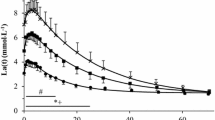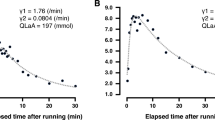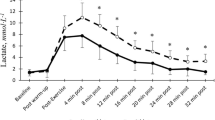Abstract
The goal of this study was to test the hypothesis that, in groups of highly trained endurance athletes (first and junior national teams), the final blood lactate concentration at maximum aerobic performance decreased as their training status increased. This study was performed with 20 physically active volunteers and 45 highly trained middle- and long-distance endurance athletes (speed skaters, triathletes, and cross-country skiers). Significant negative correlations (r = −0.59 to −0.87) between the final blood lactate concentration after incremental tests until exhaustion and aerobic performance (anaerobic threshold (AT)) were found only for the groups of highly trained endurance athletes, but not for the group of physically active subjects. It was shown for highly trained speed skaters that the final lactate concentration in their blood decreased and the oxygen consumption at AT increased with an increase in the volume of type I muscle fibers in the working muscle (r = −0.84 and r = 0.7, respectively).
Similar content being viewed by others
References
Mader, A., Evaluation of the Endurance Performance of Marathon Runners and Theoretical Analysis of Test Results, J. Sports Med. Phys. Fitness, 1991, vol. 31, p. 1.
Komi, P.V., Ito, A., Sjodin, B., Wallenstein, R., and Karlsson, J., Muscle Metabolism, Lactate Breaking Point, and Biomechanical Features of Endurance Running, Int. J. Sports Med., 1981, vol. 2, p. 148.
Popov, D.V., Bravyi, Ya.R., Lemesheva, Yu.S., Missina, S.S., Linde, E.V., Voronov, A.V., and Vinogradova, O.L., Prediction of Sports Results of Speed Skaters by the Results of Complex Morphophysiological Examination, Teor. Prakt. Fiz. Kul’t., 2008, vol. 9, p. 40.
Gollnick, P.D., Armstrong, R.B., Saubert, C.W., Piehl, K., and Saltin, B., Enzyme Activity and Fiber Composition in Skeletal Muscle of Untrained and Trained Men, J. Appl. Physiol., 1972, vol. 33, p. 312.
Henriksson, J., Chi, M.M., Hintz, C.S., Young, D.A., Kaiser, K.K., Salmons, S., and Lowry, O.H., Chronic Stimulation of Mammalian Muscle: Changes in Enzymes of Six Metabolic Pathways, Am. J. Physiol., 1986, vol. 251, p. 614.
Kindermann, W., Simon, G., and Keul, J., The Significance of the Aerobic-Anaerobic Transition for the Determination of Work Load Intensities during Endurance Training, Eur. J. Appl. Physiol. Occup. Physiol., 1979, vol. 42, p. 25.
Voronov, A.V., Anatomicheskoe stroenie i biomekhanicheskie kharakteristiki myshts i sustavov nizhnikh konechnostei (Anatomical Structure and Biochemical Characteristics of Muscles and Joints of Lower Extremities), Moscow, 2003.
Bangsbo, J. and Juel, C., Counterpoint: Lactic Acid Accumulation Is a Disadvantage during Muscle Activity, J. Appl. Physiol., 2006, vol. 100, p. 1412.
Fitts, R.H., The Cross-Bridge Cycle and Skeletal Muscle Fatigue, J. Appl. Physiol., 2008, vol. 104, p. 551.
Bangsbo, J., Aagaard, T., Olsen, M., Kiens, B., Turcotte, L.P., and Richter, E.A., Lactate and H+ Uptake in Inactive Muscles during Intense Exercise in Man, J. Physiol., 1995, vol. 488,Pt. 1, p. 219.
Nielsen, H.B., Febbraio, M.A., Ott, P., Krustrup, P., and Secher, N.H., Hepatic Lactate Uptake versus Leg Lactate Output during Exercise in Humans, J. Appl. Physiol., 2007, vol. 103, p. 1227.
Schmidt, W., Prommer, N., Thoma, S., and Niss, A., The Oxygen Transport System in Kenyan Runners, in Book of Abstracts 14th Annual Congress of the Eur. College of Sport Science, 2009, p. 317.
Tesch, P., Sjodin, B., and Karlsson, J., Relationship between Lactate Accumulation, LDH Activity, LDH Isozyme and Fibre Type Distribution in Human Skeletal Muscle, Acta Physiol. Scand., 1978, vol. 103, p. 40.
Coggan, A.R., Spina, R.J., Rogers, M.A., King, D.S., Brown, M., Nemeth, P.M., and Holloszy, J.O., Histochemical and Enzymatic Characteristics of Skeletal Muscle in Master Athletes, J. Appl. Physiol., 1990, vol. 68, p. 1896.
Costill, D.L., Fink, W.J., and Pollock, M.L., Muscle Fiber Composition and Enzyme Activities of Highly Trained Distance Runners, Med. Sci. Sports, 1976, vol. 8, pp. 96–100.
Inbar, O., Kaiser, P., and Tesch, P., Relationships between Leg Muscle Fiber Type Distribution and Leg Exercise Performance, Int. J. Sports Med., 1981, vol. 2, p. 154.
Jansson, E. and Kaijser, L., Substrate Utilization and Enzymes in Skeletal Muscle of Extremely Endurance-Trained Men, J. Appl. Physiol., 1987, vol. 62, p. 999.
Leblanc, P.J., Peters, S.J., Tunstall, R.J., Cameron-Smith, D., and Heigenhauser, G.J., Effects of Aerobic Training on Pyruvate Dehydrogenase and Pyruvate Dehydrogenase Kinase in Human Skeletal Muscle, J. Physiol., 2004, vol. 557, p. 559.
Apple, F.S. and Rogers, M.A., Skeletal Muscle Lactate Dehydrogenase Isozyme Alterations in Men and Women Marathon Runners, J. Appl. Physiol., 1986, vol. 61, p. 477.
Apple, F.S., Tesch, P.A., CK and LD Isozymes in Human Single Muscle Fibers in Trained Athletes, J. Appl. Physiol., 1989, vol. 66, p. 2717.
Saltin, B., Kim, C.K., Terrados, N., Larsen, H., Svedenhag, J., and Rolf, C.J., Morphology, Enzyme Activities and Buffer Capacity in Leg Muscles of Kenyan and Scandinavian Runners, Scand. J. Med. Sci. Sports, 1995, vol. 5, p. 222.
Brooks, G.A., Dubouchaud, H., Brown, M., Sicurello, J.P., and Butz, C.E., Role of Mitochondrial Lactate Dehydrogenase and Lactate Oxidation in the Intracellular Lactate Shuttle, Proc. Natl. Acad. Sci. USA, 1999, vol. 96, p. 1129.
Hakimi, P., Yang, J., Casadesus, G., Massillon, D., Tolentino-Silva, F., Nye, C.K., Cabrera, M.E., Hagen, D.R., Utter, C.B., Baghdy, Y., Johnson, D.H., Wilson, D.L., Kirwan, J.P., Kalhan, S.C., and Hanson, R.W., Overexpression of the Cytosolic Form of Phosphoenolpyruvate Carboxykinase (GTP) in Skeletal Muscle Repatterns Energy Metabolism in the Mouse, J. Biol. Chem., 2007, vol. 282, p. 32844.
Author information
Authors and Affiliations
Additional information
Original Russian Text © D.V. Popov, S.S. Missina, Yu.S. Lemesheva, E.V. Lyubaeva, A.S. Borovik, O.L. Vinogradova, 2010, published in Fiziologiya Cheloveka, 2010, Vol. 36, No. 3, pp. 102–109.
Rights and permissions
About this article
Cite this article
Popov, D.V., Missina, S.S., Lemesheva, Y.S. et al. Final blood lactate concentration after incremental test and aerobic performance. Hum Physiol 36, 335–341 (2010). https://doi.org/10.1134/S0362119710030138
Received:
Published:
Issue Date:
DOI: https://doi.org/10.1134/S0362119710030138




